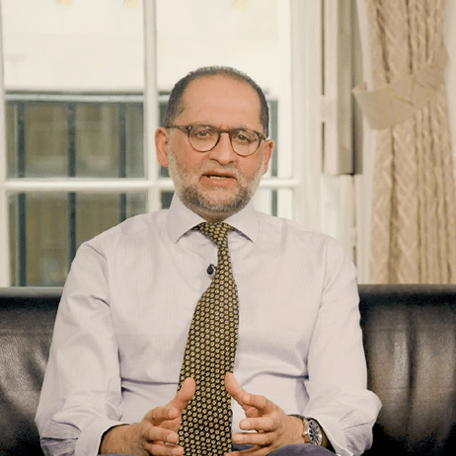During August, we both cut back long positions and increased the short futures positions, while also rotating the long positions to a slightly more cyclical footing. The result has been a relatively sharp reduction in the Fund’s net exposure. There were three factors driving these changes.
First, we think the low volume levitation of equity markets over the summer (the Nasdaq 100 rallied 24% from the June lows to the August highs) is probably a bear market rally as opposed to the start of a new bull run. The primary reason for this is that US equity P/E multiples remain historically high. As the market topped out in mid-August, the S&P 500 P/E hit 19x, a level only eclipsed during the dotcom bubble and the pandemic (as the ‘E’ fell).
At the same time, US corporate profits are currently 12.3% of GDP, again a level rarely eclipsed (the historic range is 6.5% to 12.5%). Finally, it is likely that S&P 500 earnings per share (EPS) forecasts are going to be cut – partly due to the lagged effect of monetary tightening (with industrial lead indicators already having dropped sharply) and partly due to the effect of the red-hot dollar, currently up 19.5% year on year (YoY) on a trade weighted basis. Elevated profits, high multiples and profit downgrades do not usually lead to strong equity returns. Given US equities are 70% of the MSCI World index, this is obviously a problem for the overall market.
Second, Quantitative Tightening (QT) is set to take a big step up in September. The monthly caps on the shrinkage of the Fed balance sheet have been $47.5 billion for the last three months, which is $570 billion or 6.4% annualized. In September, the caps were to increase to $95.0 billion, which is $1140 billion or 12.9% annualized. For various technical reasons, since the Fed started QT on 1 June, its balance sheet has only shrunk by $88 billion in total, or 3.6% annualized. QT so far looks like a tiny blip compared to the massive amount of Quantitative Easing (QE) that preceded it. From September, there was likely to be a dramatic pick up in the rate of decline in the balance sheet, which will remove liquidity from the financial system. This is likely to weigh on asset prices generally but particularly those in the US, where valuations are high and profit margins are elevated.
Third, while the US equity market is expensive, there are some significant pockets of value in global markets. For instance, the Stoxx 600 is trading at a historically wide price to earnings (P/E) discount to the S&P 500 of -35%. This is perhaps unsurprising given the litany of woe facing Europe currently, but markets are forward looking and a lot of bad news is now discounted. It is also worth remembering the flip side of a strong dollar is a weak euro, a boon for both translation and transaction effects for European companies. In addition, cyclicals are trading at wide discounts to defensives given widespread fears of imminent recession, again reflecting a lot of bad news.
Pulling these three things together, we came to the conclusion it was sensible to both reduce overall long exposure and increase short futures positions to bring down the Fund’s overall exposure to equity market movements, while at the same time increasing the low valuation tilt by adding to cyclical positions, particularly in Europe. The median P/E of the Fund’s long positions is now 10x, while the P/E of the Fund’s S&P 500 futures shorts is currently 17x.
We noted above that ISM New Orders has declined sharply. However, within the ISM report in early September, there was also some very good news. ISM prices paid also slumped and is now below its historical average. This is a measure of inflationary pressure in companies’ supply chains and points to the fact that the worst could be starting to ease. Sharp declines in prices paid also tend to lead pick-ups in new orders, which point to the fact that industrial lead indicators could bottom moving into 2023.
Another piece of good news on the inflation front came from the August US payroll report. This showed that the US participation rate rebounded to 62.4%. Participation in the US labour market is in long-term structural decline due to the ageing of the population. However, it slumped sharply during the pandemic and has been slow to rebound. The recent bump in the participation rate meant that the US unemployment rate increased from 3.5% to 3.7% in August despite a 315,000 increase in payrolls. This indicates some modest cooling of the red-hot US labour market, again pointing to some cooling of underlying inflationary pressures.
China/US relations are currently in the deep freeze with Nancy Pelosi’s visit to Taiwan putting the cherry on top of a period of persistent acrimony. However, there was also recently a sign China realises that maybe things have gone too far and at least a partial reset is required. This is likely to be related to efforts by the government to stabilize the Chinese economy in the run up to the Party Congress in the autumn.
The Chinese government has also been stepping up its stimulus programs in an effort to offset weakness caused by its zero covid policy. Premier Li Keqiang stated at a meeting of the State Council that its policies in 2022 have been more ‘forceful’ than in 2020 and pledged to stabilise employment and prices. The State Council also laid out a new 19-point package to support the economy including the ailing property sector. The only major market that investors seem more downbeat about than Europe currently is China.
Surging energy prices, particularly in Europe, have the press loaded up with doom. The gas price in Europe recently hit a peak of 7.5x the previous high set in 2008. Consumers are facing enormous energy bills over the winter, although it seems highly likely that governments are going to protect consumers from the worst of the energy price spikes for the simple reason that they have no choice. For example, Germany just announced it would increase its energy aid package by €65 billion to €95 billion. This package includes electricity price caps, a cut in VAT on gas and one-off payments to pensioners and students. Italy is currently expected to spend €50 billion on subsidies, France €45 billion and Spain €27 billion. As with Germany, it is highly likely that these sums will be increased.
Governments simply need to navigate these price spikes until they can bring the energy markets back into balance through better diversity of supply and measures to reduce demand. More news on further subsidies would also be positive news for European cyclicals.
One long running bear case for the global economy is the excessive amount of debt around the world. An obvious solution to this problem would be to write some of it off. You could argue central banks have already done this to a degree by buying government debt – this effectively eliminates interest payments on the debt they have bought as the coupons are remitted back to treasury departments.
Shifting on to more negative news, the most worrying factor in markets is the inverted US yield curve. The yield on US 10-year bonds minus the yield on US 2-year bonds is currently (at the moment of writing) -20bps, having hit -40bps in mid-August. The yield curve has only hit such inverted levels twice in the last 50 years: a prolonged period from the late 1970s to the early 1980s when US inflation was soaring and at the peak of the dotcom bubble. An inverted yield curve usually signals trouble ahead. This would be a particular problem for the highly valued US equity market, especially with QT about to get into full swing.
The NAHB housing index in the US tends to be a pretty early and good lead indicator of the US economy. It has recently dropped sharply owing to the effect of the surge in US mortgage rates. A cooling housing sector tends to have widespread effects on the economy given the amount of expenditure that is driven by people moving house.
The inverted yield curve and sharp drop in the NAHB index mean it is likely that it’s not just Europe which is facing troubled waters.
In terms of the rest of the macro environment, there are lots of cross currents that can be spun various ways, although on balance there do seem to be a number of positive developments that argue for flexibility and against becoming too doggedly bearish.
KEY RISKS
Past performance is not a guide to future performance. The value of an investment and the income generated from it can fall as well as rise and is not guaranteed. You may get back less than you originally invested. The issue of units/shares in Liontrust Funds may be subject to an initial charge, which will have an impact on the realisable value of the investment, particularly in the short term. Investments should always be considered as long term.
Investment in the Fund involves foreign currencies and may be subject to fluctuations in value due to movements in exchange rates. The Fund may invest in derivatives. The use of derivatives may create leverage or gearing. A relatively small movement in the value of a derivative's underlying investment may have a larger impact, positive or negative, on the value of a fund than if the underlying investment was held instead.
DISCLAIMER
This is a marketing communication. Before making an investment, you should read the relevant Prospectus and the Key Investor Information Document (KIID), which provide full product details including investment charges and risks. These documents can be obtained, free of charge, from www.liontrust.co.uk or direct from Liontrust. Always research your own investments and if you are not a professional investor please consult a regulated financial adviser regarding the suitability of such an investment for you and your personal circumstances.
This should not be construed as advice for investment in any product or security mentioned, an offer to buy or sell units/shares of Funds mentioned, or a solicitation to purchase securities in any company or investment product. Examples of stocks are provided for general information only to demonstrate our investment philosophy. The investment being promoted is for units in a fund, not directly in the underlying assets. It contains information and analysis that is believed to be accurate at the time of publication, but is subject to change without notice. Whilst care has been taken in compiling the content of this document, no representation or warranty, express or implied, is made by Liontrust as to its accuracy or completeness, including for external sources (which may have been used) which have not been verified. It should not be copied, forwarded, reproduced, divulged or otherwise distributed in any form whether by way of fax, email, oral or otherwise, in whole or in part without the express and prior written consent of Liontrust.







